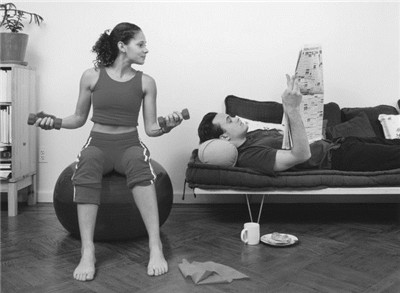(单词翻译:单击)
Spouses influence each other’s exercise habits, for better and worse, more than is often recognized, according to an interesting new study of the workout habits of middle-aged couples. The study found that changes in one spouse’s routine tend to be echoed in the other’s, highlighting the extent to which our exercise behavior is shaped not just by our personal intentions but by the people around us as well.
一项有趣的新研究在考察了中年夫妇的锻炼习惯后提出,配偶可以影响彼此的运动习惯,这种影响有好有坏,且其程度往往超出了人们的预计。该研究发现,夫妻中任何一方生活日程的改变往往是与对方相呼应的,这表明,我们的锻炼行为不仅仅出自个人的意愿,我们周围的人对此也功不可没。
In studying why people opt to exercise or not, scientists often and understandably focus on individual psychology and situations. But increasingly, exercise scientists are also looking into broader factors that can have a bearing, including our social relationships and whether being single, married, childless or employed is likely to affect exercise behavior.
在探讨是什么原因促使人们选择进行锻炼(或不锻炼)时,科学家们经常理所当然地侧重于研究个人的心理和身体状况。现在,有越来越多的运动科学家将更广泛的因素纳入考虑,例如,他们开始调查社会关系以及单身、已婚、无子女或就业等状态是否可能影响到人们的锻炼行为。

The results of past studies on this subject have been alternately predictable and startling. Single men and women, for instance, generally exercise far more than do married people, although divorce can change that. Men typically exercise more after a marriage ends; women in that situation frequently exercise less. Meanwhile, employed men, even those with desk jobs, usually exercise more than men who are unemployed.
关于这一问题,以前也进行过一些研究,其结果有的在意料之中,也有的令人震惊。例如,单身男女的运动量通常会远多于已婚男女,但离婚后这种状况会有所改变。在结束一段婚姻之后,男性一般会加大运动量,女性则往往相反。另一方面,在职的男性,即使他们从事的是文书工作,一般也会比失业的男性更多地从事体育运动。
Parenthood, though, has the greatest downward pull on planned exercise time. In a number of studies in recent years, scientists have found that mothers of even one child exercise considerably less than do the childless, although, perhaps not surprisingly, they often complete more light activity, which would include cooking, cleaning and scrambling after streaking toddlers, than do the childless. Meanwhile, fathers of a single child often exercise as much as they did before becoming a parent, but fathers of more than one child experience a large and rapid decline in their formal exercise time.
为人父母是让计划好的运动时间大大缩水的最强力因素。在近年来的一些研究中,科学家们发现,与无子女的女性相比,哪怕成为一个孩子的母亲也会让她们的运动时间大为减少,但是她们完成的轻度活动,如烹饪、打扫卫生以及追在蹒跚学步的孩子后面跑等等行为要比没有孩子的女性多——这倒也不足为奇。而独生孩子的父亲的运动量与成为父亲前没什么两样,不过一旦孩子的数量超过两个,他们正正经经地做运动的时间就会迅速地大幅下降。
There has been surprisingly little examination, however, of how marriage affects exercise in the years after a couple’s children have grown, and especially whether and how changes in one spouse’s exercise routine at that point affect the other spouse.
然而,关于子女长大多年以后婚姻会如何影响夫妻两人的运动情况,尤其是此时其中一方的运动习惯的改变能否以及将如何影响配偶,研究却少得惊人。
So, for the new study, which was presented this month at a scientific meeting of the American Heart Association in Baltimore, researchers from Johns Hopkins University and other institutions turned to data from the large-scale Atherosclerosis Risk in Communities Study, which includes answers to health-related questionnaires from thousands of middle-aged American adults. Most of the participants answered the questionnaires multiple times, beginning in the late 1980s.
本月初在巴尔的摩举行的美国心脏协会(American Heart Association)科学会议上发表的一项新研究中,约翰斯·霍普金斯大学(Johns Hopkins University)和其他机构的研究人员参考了大规模的“社区动脉粥样硬化风险研究(Atherosclerosis Risk in Communities Study)”中的数据,包括数以千计的美国中年人填写的健康相关问卷。大多数参与者从20世纪80年代末起,多次回答过这些调查问卷。
The researchers looked for data related to exercise from 3,261 healthy, middle-aged, married couples with an average age of about 55, each of whom had filled out the questionnaires at least twice, with about six years between their answers.
研究人员分析了3261名健康的中年已婚夫妇的运动相关数据,他们的平均年龄为55岁,每人都至少填过两次问卷,且填写问卷的时间间隔约为六年。
As a benchmark, the researchers focused on whether, according to their first questionnaire, each husband or wife had met the standard recommendation for exercise to improve health, which amounts to 30 minutes of moderate exercise at least five times a week. (These married couples consisted of a man and a woman.)
研究人员们考察了每一位丈夫或妻子在填写第一份问卷时是否达到了促进健康的建议标准运动量(即每周进行至少五次中等强度的锻炼),并以此作为研究基准。(上述的已婚夫妇均由一名男性和一名女性构成。)
Then the scientists determined whether either of the middle-aged spouses had altered his or her exercise habits between questionnaires, and whether the couple’s exercise routines had converged or grown more different during those years.
然后,科学家们探讨了这些中年夫妇在后来填写问卷时,他或她的运动习惯是否发生了改变,以及在此期间,夫妻双方的运动习惯是更加接近了还是差异更大了。
What they found was that the older couples’ exercise routines tended to become strikingly similar at this point in their lives.
他们发现,到了人生的这个阶段,中年夫妇的运动习惯往往变得惊人地相似。
If a woman met the standard recommendation for exercise during her first questionnaire and her husband did not, he was 70 percent more likely to be meeting those recommendations six years later than were men whose spouses did not exercise much, so long as the woman was still exercising regularly.
如果妻子在第一次问卷调查时达到了建议的标准运动量,而她的丈夫反之,那么,只要妻子还在定期锻炼,其丈夫在六年后达到上述建议运动量的可能性比妻子运动不足的那些丈夫们要高出70%。
Similarly, if a husband met the recommendations during his first questionnaire and his wife did not, she was about 40 percent more likely to be meeting those recommendations a few years later than were women whose husbands were and remained sedentary.
同样,如果丈夫在第一次问卷调查时达到了建议的标准运动量而妻子反之,那么妻子在几年后达到建议运动量的可能性要比丈夫习惯久坐的妻子们高出40%。
Less encouraging, if one spouse eased off or eschewed exercise during the years between questionnaires, his or her spouse usually followed suit.
令人遗憾的是,如果在这些年期间,配偶中一方运动热情减退或者开始逃避锻炼,另一方通常也会效尤。
The implication, says Laura Cobb, a graduate student at Johns Hopkins who led the study, is that “spouses can play an outsized role” in exercise behavior during middle age.
该研究的负责人,约翰斯·霍普金斯大学的研究生劳拉·科布(Laura Cobb)说:这意味着中年“夫妇可对对方的锻炼行为造成巨大的影响”。
Of course, the study relies on self-reported, prospective information, she says, and so “can’t prove” that one spouse’s exercise habits directly affect the other’s. “It’s equally possible,” she says, “that other shared lifestyle factors,” such as retirement or a move to a new neighborhood, could be influential. (The scientists controlled for health problems by not including couples if one spouse had or developed a major disease.)
当然,由于这项研究依赖于参与者自我报告的前瞻性信息,因此它“不能证明”配偶中一方的运动习惯可以直接影响到另一方,她说。“夫妻双方共享的其他生活方式因素,”如退休或迁居到新的社区,同样可能有一定作用。(科学家排除了一方曾罹患或现存在重大疾病的夫妇,从而对参与者的健康问题进行了校正。)
But the neat alignment between one middle-aged spouse’s workouts and, after a few years, the other’s does suggest, Ms. Cobb says, that to inspire your spouse to work out more, you should probably begin by ramping up your own routine. And if you hope to maintain that regimen into the future, nudge a sedentary spouse to join you. Otherwise it can be sorely tempting to settle onto the couch yourself.
但科布女士认为,几年之内中年夫妇的运动习惯就齐刷刷地趋于一致,这一发现表明,如果你想要激励你的另一半多多锻炼,那么很可能需要从增加你自己的日常运动量开始。而且,如果你希望以后也能将这样的运动习惯保持下去,就鼓动你那个喜欢久坐的配偶来陪你吧。不然的话,搞不好你会拒绝不了像他一样窝在沙发上的诱惑呢。


